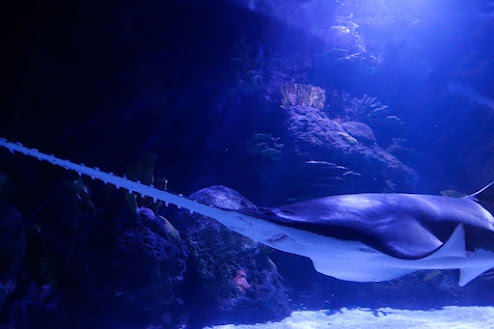Unraveling the Enigma of Florida's Smalltooth Sawfish: Behaviors, Threats, and Conservation Challenges
Fish Are Behaving Erratically and Dying. No One Knows Why
Introduction:
Nestled within the sun-kissed waters of Florida, a captivating marine species, the smalltooth sawfish, grapples with a perplexing plight that has captured the attention of scientists and conservationists alike. Recent observations reveal a tapestry of unusual behaviors and alarming mortality rates among these enigmatic creatures, signaling potential distress within their fragile ecosystem. As researchers delve deeper into the mysteries surrounding smalltooth sawfish, pressing questions emerge about the root causes of their decline and the pathways toward effective conservation strategies.
Unusual Behavior Patterns:
Against the backdrop of Florida's coastal waters, smalltooth sawfish have been observed displaying atypical swimming patterns and exhibiting signs of disorientation. These behaviors, considered aberrant for this species, have raised concerns among scientists about the underlying factors driving such anomalies. The significance of these observations extends beyond mere curiosity, hinting at potential environmental stressors that may be impacting the well-being of smalltooth sawfish populations.
Scientific Investigations Unveil Disturbing Trends:
A collaborative effort spearheaded by the Florida Fish and Wildlife Conservation Commission (FWC) has sought to unravel the complexities surrounding smalltooth sawfish populations. Their comprehensive study, published in the esteemed journal Endangered Species Research, provides a sobering glimpse into the challenges facing these iconic marine animals. Analysis of data reveals a troubling trend of premature mortality among smalltooth sawfish, with a notable proportion displaying indicators of stress and malnutrition.
Environmental Stressors and Human Impact:
The intricate web of factors contributing to the precarious situation of smalltooth sawfish encompasses a range of environmental stressors exacerbated by human activities. Habitat degradation, stemming from coastal development and habitat loss, poses a significant threat to the species' survival. Moreover, pollution and overfishing exert additional pressures, disrupting the delicate equilibrium of their marine habitat. The cumulative impact of these anthropogenic stressors underscores the urgent need for concerted conservation efforts to mitigate further decline.
Quotes from Experts:
Dr. Sarah Frias-Torres, a respected marine scientist not directly involved in the study, articulated her concerns, stating, "The observed behavioral shifts in smalltooth sawfish are cause for alarm. These magnificent creatures are integral to the ecological balance of coastal ecosystems, and their decline could have far-reaching consequences."
Dr. Gregg Poulakis, a biologist leading the research efforts at FWC, echoed these sentiments, emphasizing the imperative for immediate action. He asserted, "We cannot afford to overlook the warning signs. Without decisive intervention to protect smalltooth sawfish and their habitats, we risk irreversible losses."
Implications for Conservation Efforts:
The findings of the study underscore the urgency of implementing robust conservation measures to safeguard smalltooth sawfish populations. Efforts aimed at habitat restoration, coupled with stringent regulations on fishing practices and pollution control, are imperative to stem the tide of decline. Moreover, fostering public awareness and community engagement is crucial in garnering support for conservation initiatives and instigating positive behavioral changes.
Future Directions and Research Priorities:
Looking ahead, scientists are poised to embark on further research endeavors to unravel the underlying causes of the observed behavioral anomalies and mortality rates among smalltooth sawfish. By elucidating these mysteries, researchers aim to inform targeted conservation strategies that address the root causes of decline while promoting the long-term sustainability of marine ecosystems. Collaborative partnerships between government agencies, research institutions, and conservation organizations will be pivotal in advancing scientific understanding and catalyzing impactful conservation action.
Conclusion:
The plight of Florida's smalltooth sawfish serves as a poignant reminder of the interconnectedness of marine ecosystems and the critical importance of proactive conservation efforts. As we confront the multifaceted challenges threatening their existence, there exists a collective imperative to preserve these emblematic species for future generations. By heeding the insights gleaned from scientific inquiry and embracing a shared commitment to environmental stewardship, we can forge a path towards a more resilient and harmonious coexistence with the natural world.
Disclaimer:
This summary is based on the original news article titled "Florida’s Smalltooth Sawfish Are Behaving Erratically and Dying" published by The New Republic. While efforts have been made to accurately convey the main points of the article, please refer to the original source for complete information. The link to the original article is provided for further reference: [Original News Article]





Comments
Post a Comment